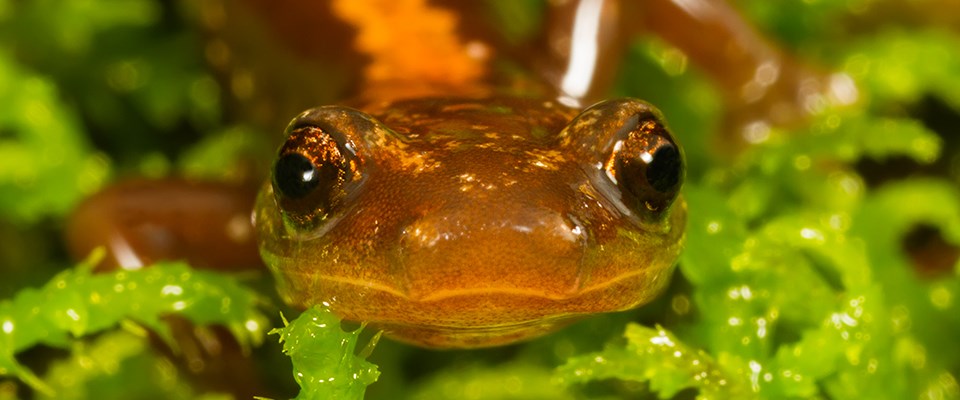
IntroductionThe Shenandoah Salamander is an endangered species found only in Shenandoah National Park. This rare salamander is a member of the family Plethodontidae, which encompasses lungless salamanders that "breathe" through their skin. Successful respiration depends on the ability to maintain skin moisture. This characteristic restricts their body size and influences the ecological roles of terrestrial salamanders. The lungless salamanders are a highly successful group that are believed to have originated in the Appalachians of eastern North America. Physical DescriptionThe Shenandoah Salamander is a small species of Plethodon reaching a total length of 7-10cm. Two distinct color phases exist - a striped phase with a narrow red to yellow stripe along the length of the dorsal surface and an unstriped or uniformly dark phase. Some dark phase individuals may also have scattered brassy colored flecks. The Shenandoah Salamander can be distinguished from its close relative the Red-backed Salamander externally by stripe width (equal to 1/3 of total body width in the Shenandoah Salamander vs. 2/3 of total body width in Red-backed Salamander) along with the absence of a strongly mottled "salt and pepper" patterned underside (present in the Red-backed Salamander but not in the Shenandoah Salamander). Adult Shenandoah Salamanders are also slightly larger and have more broadly rounded heads than do Red-backed Salamanders. Physical DescriptionLittle is know about the Shenandoah Salamander's life history, but it is likely that females do not breed before four years of age. Breeding probably occurs in late spring or summer and fertilization is internal. Females lay eggs every other year with an average clutch size of 13 eggs which are laid in damp logs, moss, or moist crevices. Incubation lasts one to three months and development occurs completely within the egg. Females guard eggs and do not forage for food during this time. Eggs hatch in summer or fall. Adults appear to survive for long periods with a few possibly surviving as long as 25 years. Habitat and RangeAll members of the genus Plethodon are terrestrial, and they are usually found in forested areas. Forest cover is important because it shades the soil and leads to higher surface ground moisture, which is critical to these terrestrial salamanders. The Shenandoah Salamander is only found on high elevation peaks within the Shenandoah National Park. The cool, moist conditions that the species requires only exist at these higher elevations because temperatures tend to be cooler and the mountain tops are more often bathed in fog. In addition to temperature and moisture, competition with the widespread red-backed salamander also contributes restricts the Shenandoah salamander's range. The small range and narrow habitat requirements of the Shenandoah Salamander led to its listing as endangered under the Endangered Species Act. BehaviorThe Shenandoah Salamander is primarily nocturnal and hides beneath rocks, logs, and other objects during the day. The Shenandoah Salamander escapes freezing temperatures in the winter as well as hot, dry conditions in the summer by retreating beneath the soil surface, where temperature and moisture conditions are more stable. DietWoodland salamanders, including the Shenandoah Salamander eat mites, flies, small beetles, springtails, and other invertebrates that are found in the soil. Ecosystem RoleFor most visitors, salamanders, including the Shenandoah Salamander, are rarely given much thought unless you are an amphibian enthusiast. This is unfortunate because salamanders serve several important ecological roles. These include predation on insects and other invertebrates, soil aeration and influence on soil dynamics brought about by burrowing, and they are a food source to other forest animals. Their predation on insects also influences ecosystem processes such as decomposition. Endangered SpeciesThe Shenandoah Salamander was listed as Federally Endangered in 1989 and this listing provides it with certain protections under federal law. It was originally listed because of its restricted range, limitations on range expansion, and potential threats within defined population areas. Because it is an endangered species, it is against the law to try and capture, observe, or disturb this rare species or the habitats where it lives. ThreatsAlthough its range falls entirely within a National Park where protection might be assumed, there are many threats to this species. Periodic infestation of park forests by non-native insects and disease that result in defoliation and tree mortality alter habitat for the salamander. Acid deposition is believed to be altering park soil conditions. This, in turn, could alter hydro-chemical conditions that the Shenandoah Salamander needs, could alter forest vegetation growth and development thus changing habitat, and could affect soil organisms that are consumed. Human use of the park (hiking, camping, trail maintenance, etc.) could also have impacts on the salamander. Finally, given that the salamander is only found at higher elevations where the climate is relatively cool, it is likely the climate changes may have a negative impact on the species. The National Park Service is currently working with partners to better understand the Shenandoah Salamander. Monitoring is being conducted to further describe the species' range and to characterize its abundance. Work is also being done to further minimize local human impact on the salamander, such as hiking and camping. In addition, major effects are being made to understand the potential impacts of climate change on this rare species. |
Last updated: September 28, 2022

